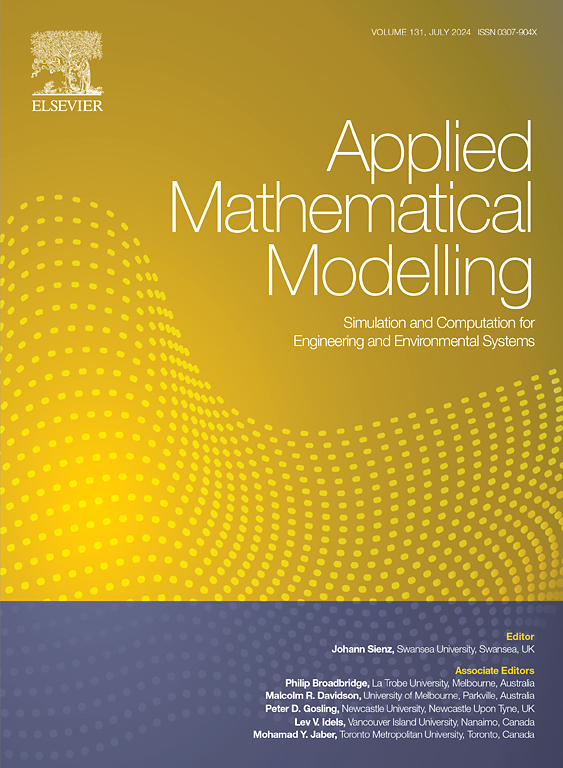Koopman modeling for optimal control of the perimeter of multi-region urban traffic networks
IF 4.4
2区 工程技术
Q1 ENGINEERING, MULTIDISCIPLINARY
引用次数: 0
Abstract
The purpose of perimeter control is to regulate the transfer flow between the perimeters of the urban traffic network, so that the vehicle aggregation in each region is maintained at a desired level. It is regarded as one of the most important methods to solve traffic congestion in urban road networks. Accurate mathematical modeling of perimeter controlled traffic dynamics remains a challenge due to its high nonlinearity and uncertainty. Machine learning methods have been used to learn traffic dynamic models for perimeter control. However, these existing techniques lack generalization and interpretability. In this paper, we propose a Koopman modeling approach (i.e., a two-stage method) that uses a new eigenfunction of the Koopman operator based on a novel norm approximation to construct an interpretable finite-dimensional approximation of the Koopman operator, which is a linear operator that describes how eigenfunctions evolve along the trajectory of a specific nonlinear dynamical system. The main advantage of utilizing the Koopman operator is that it can characterize the nonlinear system in a global linear lifted feature space. Furthermore, an algorithm based on the Koopman modeling method and model predictive control is proposed for real-time perimeter control of urban road networks. Some experiments are carried out to demonstrate the effectiveness of the proposed algorithm.
多区域城市交通网络周边优化控制的库普曼模型
周界控制的目的是调节城市交通网络周界之间的换乘流量,使每个区域的车辆聚集度保持在一个理想的水平。它被认为是解决城市路网交通拥堵的最重要方法之一。由于周界控制交通动态具有高度的非线性和不确定性,因此对其进行精确的数学建模仍是一项挑战。机器学习方法已被用于学习周边控制的交通动态模型。然而,这些现有技术缺乏通用性和可解释性。在本文中,我们提出了一种 Koopman 建模方法(即两阶段方法),该方法基于新颖的 L0 规范近似,使用 Koopman 算子的新特征函数来构建 Koopman 算子的可解释有限维近似值,Koopman 算子是一种线性算子,用于描述特征函数如何沿着特定非线性动态系统的轨迹演变。利用库普曼算子的主要优势在于,它可以在全局线性提升特征空间中描述非线性系统的特征。此外,还提出了一种基于 Koopman 建模方法和模型预测控制的算法,用于城市路网的实时周界控制。通过一些实验证明了所提算法的有效性。
本文章由计算机程序翻译,如有差异,请以英文原文为准。
求助全文
约1分钟内获得全文
求助全文
来源期刊

Applied Mathematical Modelling
数学-工程:综合
CiteScore
9.80
自引率
8.00%
发文量
508
审稿时长
43 days
期刊介绍:
Applied Mathematical Modelling focuses on research related to the mathematical modelling of engineering and environmental processes, manufacturing, and industrial systems. A significant emerging area of research activity involves multiphysics processes, and contributions in this area are particularly encouraged.
This influential publication covers a wide spectrum of subjects including heat transfer, fluid mechanics, CFD, and transport phenomena; solid mechanics and mechanics of metals; electromagnets and MHD; reliability modelling and system optimization; finite volume, finite element, and boundary element procedures; modelling of inventory, industrial, manufacturing and logistics systems for viable decision making; civil engineering systems and structures; mineral and energy resources; relevant software engineering issues associated with CAD and CAE; and materials and metallurgical engineering.
Applied Mathematical Modelling is primarily interested in papers developing increased insights into real-world problems through novel mathematical modelling, novel applications or a combination of these. Papers employing existing numerical techniques must demonstrate sufficient novelty in the solution of practical problems. Papers on fuzzy logic in decision-making or purely financial mathematics are normally not considered. Research on fractional differential equations, bifurcation, and numerical methods needs to include practical examples. Population dynamics must solve realistic scenarios. Papers in the area of logistics and business modelling should demonstrate meaningful managerial insight. Submissions with no real-world application will not be considered.
 求助内容:
求助内容: 应助结果提醒方式:
应助结果提醒方式:


